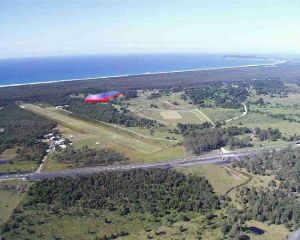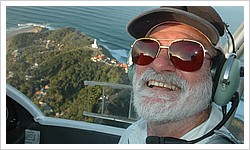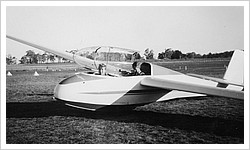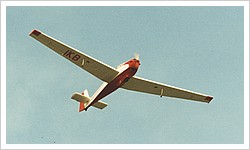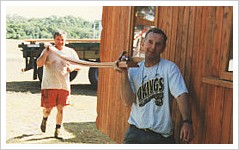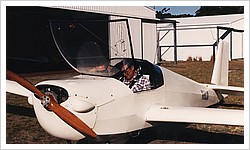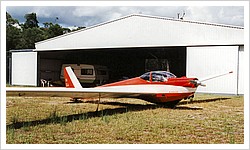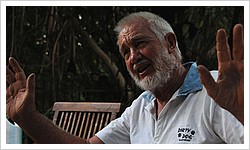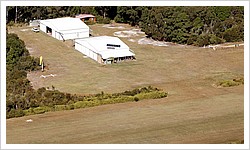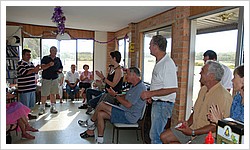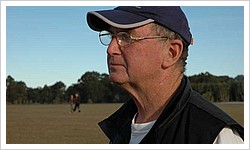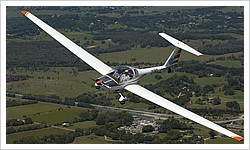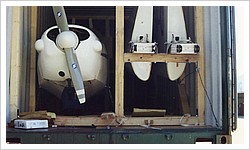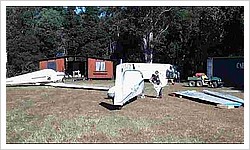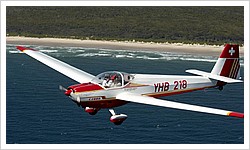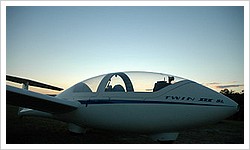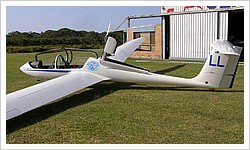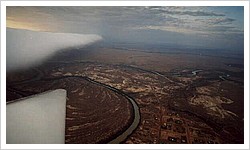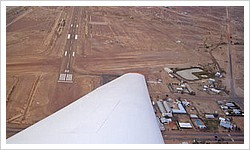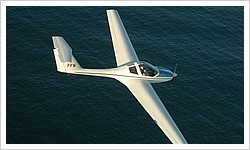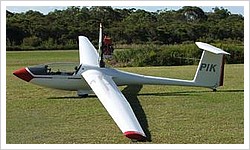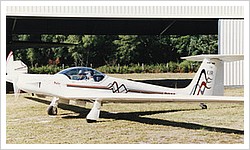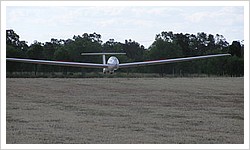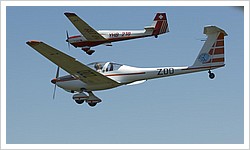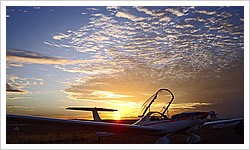HISTORY OF THE BYRON BAY GLIDING CLUB
By John Duffy
The Byron Power Gliding Club was officially established in 1992 with its inaugural meeting being held at Tyagarah Airfield Community Hall. Giles Taylor, a local doctor at Mullumbimby, was elected as the club’s first president. Jack Iggulden, who was the Gliding Federation of Australia’s first member, became the club’s patron. Ian McPhee agreed to be the first “long distance” Chief Flying Instructor as at that time he was still living and operating at Lake Keepit Gliding Club near Tamworth.
Brian Marshall, Giles Taylor and Brett Iggulden, Jack’s son, were initially endorsed as the club’s first level 1 instructors at the Grafton Gliding Club in 1993, they later upgraded their ratings to Level 2 at Lake Keepit. There were about 15 members in the fledgling gliding club and apart from the 3 instructors these included Dieter Horstman, Rick Hutgren, Chris Newns, Alan McKillop and Chris Kelman.
The first real proposal for the airstrip at Tyagarah came in February of 1970 when a committee was set up to investigate the possible construction of a 3000 foot strip there. The land on which it was to be built was owned both by the Byron Council and the Dept of Crown Lands. The first 1000′ on the western end was owned by Byron Shire Council and the remainder, about 2000′ on the eastern end, was Crown land for which Council had to obtain a lease. Construction of the airstrip began in February 1971 with many district people providing a great deal of voluntary work in conjunction with machinery loaned by the company Wendell-West, then the proprietors of the Ocean Shores landholdings where the community of Ocean Shores is today. Land was set aside on the council’s portion for private enterprise, the first applicant for its use came from Air Gold Coast. Later the Tyagarah Aero Club was formed which used the council owned hangar and a community hall was built as well.
At first with very few facilities operating improvisation was essential and, with no windsock available, the initial substitute was a small fire, so that incoming pilots could see the direction of the wind by the drift of the smoke. The fire, however, didn’t stay small, escaped control and threatened to burn out the whole strip. Showing great ingenuity, the committee then erected a pole to which they attached a 30 foot length of toilet paper as a substitute windsock.
Following an engine cylinder head cracking on the Grob after a flight to Lake Keepit, Dieter decided to return this aircraft to Germany for repair where it was subsequently sold. The club then approached Petar Novakovic, a Gold Coast eye specialist, and he allowed members to use his Grob 109B, VH XQG. This was leased by the club along with an option to buy if required. However Petar soon faced an ownership dispute with another party over this aircraft and the club was forced to look for an alternate aircraft. After several meetings at Dieter’s new home on his property adjacent to the airfield at Tyagarah it was agreed to buy a Schiebe SF25B Motorfalke with a 1200cc Stark Stammo engine.
This robust wood and metal motor glider was felt to be more suitable for the club’s needs and the coastal locality in which flying was to be done. It exhibited similar construction and docile handling characteristics similar to a pure glider manufactured by the same company, the Bergfalke 3 & 4, in which a number of members had flown quite a few hours at other clubs. The wooden wing and canvas covered steel tube fuselage was easily maintained with the advantage of an indefinite life and the Stammo engine (a glorified very early Volkswagen type engine) was easy to work on and service.
Our current club site at the eastern end of the airfield is on the Crown land portion of the strip which is leased by the Byron Shire Council. This necessitated the club obtaining a sublease from the council with Crown approval to be able to operate there. This area was originally selected, prepared and cleared by Dieter Horstman and some dedicated club members in 1992. Dieter originally arranged to take out the lease for himself. However, because of the higher commercial rates that were going to be levied on him by Byron Shire Council, he decided to hand this lease over to the club who entered into a community lease with the Byron Council in 1993 at substantially lower rates. Dieter felt that this would be advantageous both to himself and the club. He spent approximately $6000 on clearing and fencing the site.
After a few BBQ/working bees preparing the large apron and taxi space a temporary wood and metal T-hangar was erected on the leasehold to house the proposed “new” glider. This fairly rudimentary construction was built using timber and metal with blue tarp curtains at the front which tied down to pegs in front of the glider’s wings. Dieter was the club’s technical officer in this early stage and was responsible for maintenance of club aircraft and generally most else around the place.
In this year a syndicate of six members was formed to provide finance for the purchase of the “new” SF25B Motorfalke. This aircraft, VH-IKB, was bought from the Tom Gilbert/Colin Brock syndicate in Sydney. Each of the club’s new syndicate members contributed as much as they could afford with no expectation of a financial return of their capital. This motor glider was provided for use by the club with no priority given to the syndicate members with the exception that they would receive some discount on their flying fees. Brett and Giles set off to collect IKB and some members went to Lake Keepit to meet them and have their first flights. The first ferry flight was an interesting adventure being four and a half hours long. The love affair with “all things Motorfalke” began!
Dieter meanwhile decided to build his own hangar on the site and in return for use of the club’s lease granted the club one hangar space to use rent free. This 24 m x 15 m metal hangar was completed in 1995 after which the original was dismantled. This was quite a step up from the old T-hangar!
During 1995, after a disastrous fire at the Lake Keepit club, Ian McPhee decided to make his base permanently in the area and eventually placed a temporary Swiss styled cabin on the lease so that he was able to remain permanently on site to instruct members as the full-time CFI. He also helped to maintain the aircraft and adopted a caretaker role to provide security for what was a growing fleet of aircraft.
During that year membership rose to 28 putting more pressure on aircraft use. The syndicate was enlarged and the second “B” Motorfalke, VH-XJX, was purchased from the Central Coast Gliding Club. Though similar to IKB this aircraft was actually a Singsby T.61A built in England under licence from Schiebe. XJX arrived on a trailer and was eventually brought up to flying condition. Genzen Kosarka was the first Tyagarah trained pilot to go solo in the club.
Around this time Rick Hultgren decided to add to the fleet with his own private motor glider and purchased a SF25C Motorfalke, VH-GLA, from Griffith. In that year IKB flew 161 hours, GLA 38 hours and club members began to discover what the local site had to offer in terms of good thermal lift, convergence, ridge lift along Coorabell Ridge, Main Arm Valley and even wave over the Border Ranges.
In 1996 Alan Rundle joined the club. He had been involved with aircraft maintenance for many years and having attained his motor glider aircraft maintenance “ticket” took over that side of the club business from Dieter. Since that time and over many years Alan has provided valuable assistance with the club’s fleet as well as for private members owning aircraft. His knowledge and problem solving skills have helped the club immeasurably. During 1996 over 930 flights were made and over 400 hours flying done. It should be noted that both I KB and XJX early on had no electrical system and were started using a rope pull in the cockpit. This caused great consternation and many sore knuckles, and elbows for taller pilots, especially if the engine was a bit cantankerous to start. Pilots so initiated earned their eligibility into the “Bloody Knuckles Club”. These gliders were later improved and electrical systems and starter motors were installed by Alan.
Rick Hultgren who owned GLA then decided to build a second hangar for himself which was exactly the same type as Dieters, this was completed in 1996. The Building Application issued by the council required the club to construct a gravel access road. Half of this was built by club members using Dieter’s equipment and the other half built professionally to which Rick contributed financially. Dieter, along with other members, was tireless in doing things around the club, gravelling the road, putting water on, installing a septic toilet and establishing the grassed areas. In those days his contribution was immeasurable.
The foundations of the existing clubhouse, which was attached to the side of Dieter’s hangar, were poured in 1996 and the existing structure was slowly completed over the next few years from 1996 to 1998 under some quite distinctive German guidance and directions. A small 12V solar electricity system was installed with a 240V inverter as it was far too expensive to bring electricity from the other end of the strip. This was upgraded in 2006 to a more capable and larger 24V system and inverter. A new kitchen was also installed a bit later after some of the previous Bavarian touches were removed.
It was decided about that time that it would be an advantage for the club to obtain an Air Operator’s Certificate, or AOC, which enabled the club to undertake charter flights under the umbrella of the Civil Aviation Safety Authority, or CASA. This was more cost-effective for doing charter flights and, additionally, the club received added insurance cover for passengers equivalent to that of regular aviation travellers. This was fairly unique in Australia at that time for a gliding club to have such a certificate.
Ian “Macca” McPhee
The syndicate which had raised money to purchase IKB and XJX initially consisted of a group of altruistic members who, as we mentioned previously, gained little advantage from this ownership but contributed money in order to subsidise low-cost flying for other club members and to help raise funds to build and expand club facilities. This syndicate has continued throughout the years with a number of its members changing as shares were rolled over and bought and sold. The club has leased these syndicate aircraft over the years from the owners, the payment of which has allowed the syndicate to meet operating costs, re-engine and improve airframes. The club then on-sold flying to its members in order to raise funds for itself. It would be true to say that the club today largely owes its continued success and existence to the influence of this syndicate over the years.
After having been completely refurbished and fitted with a Jabiru engine the syndicate’s motor glider IKB was unfortunately destroyed in 2003 after a visiting pilot got caught in wind shear off the eastern end of the strip. The syndicate then purchased an H 36 Dimona VH-ZZD partly using the insurance money. This introduced a different and more sophisticated aircraft for club members to fly with better performance for doing cross-country touring. It also enhanced visitor’s first impressions of the club and their enjoyment of gliding.
Around 2000 to 2001 negotiations were undertaken by the club with both Dieter and Rick, the owners of the existing hangars, to purchase them for the club. A trust was set up for this purpose with funds being invested by club members and a deal was struck at a price advantageous to the club and ownership of these two hangars passed into club hands. A number of members generously loaned money to this trust with the idea that funds could be rolled over as members came and went in the club. The Trust tried to operate on the basis that there should be sufficient funds available to meet requests for redemption if the occasion arose. This proved highly successful and the hangers were fairly quickly paid off with the income generated by club flying and renting out space in the hangers.
John Crumpton, a long time member whose father taught several members to fly at Armidale Gliding Club, decided in 2001 to purchase his own aircraft and to this end he imported 2 “B” Motorfalkes from Germany. Both were in great condition and after on-selling one he kept the other and put it on line for members to use. This was a modified SF 25B with some “C” characteristics. While GLA operated within the club it changed owners a couple of times and Rick Hultgren graduated to a sophisticated new Ximango motorglider.
Dieter Horstmann, about the time of selling his hangar to the club, was motivated to move to the western end and built another hangar on his own property along the southern edge of the strip, he accessed the airfield from there. Along with a few other members he created another gliding club called Byron Bay Gliding Club which, though similarly named, was in no way connected with our club. Over the years this club has passed through a number of operators with varying degrees of success.
In late 2005 Ian McPhee and his partner Andy Jowett decided to import a C2000 Motorfalke from a flying club in Germany. This aircraft, registered YHB, had a larger 2000 cc motor and was in tail dragger configuration. This aircraft became very popular with club pilots due to its docile nature and reliability, many hours were amassed in it by members over the following years.
It was decided in late 2006 that the club, having only ever leased motor gliders, should look at perhaps buying a second-hand self launching sailplane as a club owned aircraft using trust funds. It was believed that this type of aircraft, as opposed to motor gliders, with its fully retractable engine, sleek, pure sailplane profile and much better gliding performance would bring a new dimension to members flying. Consequently when further funds were raised in the trust a Grob 103-3, two seater, self launching sailplane was purchased from the United States at considerable cost. This arrived in January 2007 but immediately was beset with mechanical and gelcoat paint problems which restricted its usage considerably. Though this was a lovely aircraft to fly it was found generally unsuitable for our coastal area, airstrip length and surface and was more technically challenging for pilots to fly consequently it didn’t get sufficient utilisation. As it was not meeting costs a decision was made by the committee to sell it in late 2008. Unfortunately, for various reasons as well as the economic climate that existed at that time, this proved quite difficult and it was not sold until early 2011 to a syndicate at Lake Keepit for about 60% of its initial cost to us. The financial impost brought on by the need to repay club members who had invested in the Trust had a stifling effect on the club’s activities and expansion for some time.
2012 Brief Update
The Grob SL has been sold, and the AOC relinquished in favour of GFA Air Experience Flights.
One of the great benefits of operating motorgliders is the flexibility it affords pilots for planning and executing trips away from the local area despite lack of thermals and lift. However we do have the advantage of being able to use the ridges and ranges to the west of the strip for slope soaring in the prevailing summer sea breezes. In particular Coorabell Ridge just behind our strip has over 15 kms of usable ridge for members to enjoy. Apart from trips over the picturesque vista of Mount Warning, the Border Ranges and the North Coast hinterland members have embarked on flights up and down the east coast of Australia from Cape York chasing the elusive Morning Glory roll cloud (one of the Holy Grails of Australian gliding!), to the Whitsundays, Lake Eyre and even as far south as Bordertown, South Australia. It is also very easy to drop into the various gliding clubs spread along the interior and eastern coastline of New South Wales and Queensland.
We are very fortunate with our club being established close to Byron Bay itself. The active tourist industry along the coast, including the Gold Coast, has meant that the club has been able to attract a broad range of people who wish to either sample gliding, try something different or engage in a so-called “adventure” experience. This passing trade has been a wonderful financial benefit for the club and has helped us to continue to grow and expand as well as being a source of new members. The rather unique opportunity of flying motorgliders has attracted members not only from the local surrounding areas but from as far away as Brisbane, and from other pure gliding clubs in South Eastern Queensland.
Though the initial emphasis in the club fleet was on Motorfalkes with the addition of the Dimona and the Grob self launcher, there have been a number of members private aircraft kept at the club. There has at times been a Grob 109A, a Ximango, another H36 Dimona, an SF27M, Motorfalke C-2000 and a PIK 20E along with a mix of light recreational sports aircraft and the occasional GA aircraft all of which add a little spice and variety to the mix. On the odd infrequent occasion there have been pure gliders launched out of the airstrip though the size of our airstrip is a little problematic for this sort of activity.
Grob Landing




